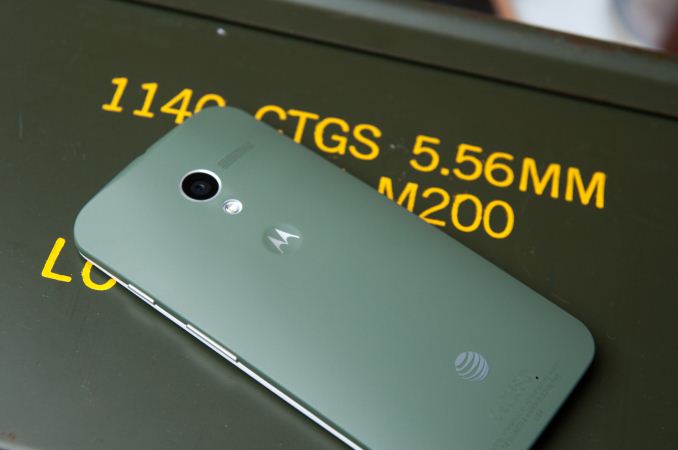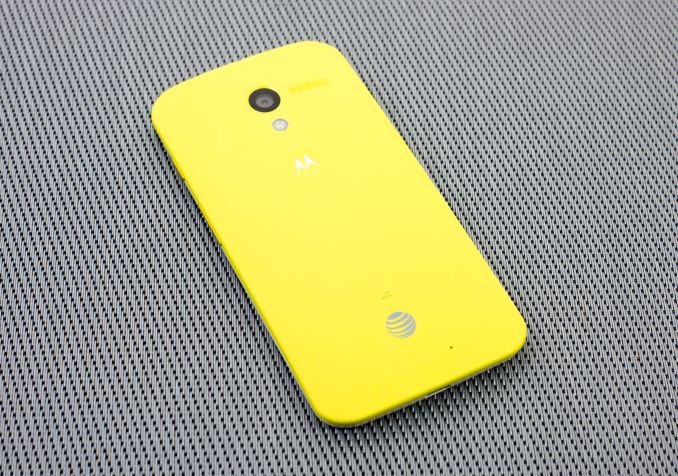Moto X Review
by Brian Klug on August 26, 2013 1:30 PM EST- Posted in
- Smartphones
- Qualcomm
- MSM8960
- Motorola
- Android
- Mobile
- Android 4.2
- Moto X
Moto Maker - A Customized Moto X
A large part of the Moto X story is the ability for users to order their own customized variants with different color combinations and an optional customized engraving (at a later date) and line of text at boot. Initially exclusive to AT&T, the Moto Maker customization tool manifests itself as a web portal where shoppers can select from 18 different back colors, 7 accent colors, and a black or white front at no additional cost. In the future there will be additional patterns and materials available, for example additional textures and the wood materials I touched on earlier later in Q4.
The workflow is simple, either shoppers go online to Moto Maker directly, or (at launch) go into an operator store, see color samples, buy a 16 or 32 GB Moto X Moto Maker pass, and then either complete the Moto Maker customization option on a kiosk at the store or later from the comfort of their home. Motorola then assembles the custom Moto X in Fort Worth, Texas and ships to anywhere in the USA with a 4 day turnaround time. Shoppers who want to walk out of an operator store with a device in hand will have to opt for the woven white or black options as mentioned before.
The initial AT&T exclusivity is disappointing if you’re on one of the four other major wireless operators in the USA, however I expect the other operators to get brought in immediately after the exclusivity period ends, but there’s no word how long that is for AT&T. The Moto Maker part of the customization experience is also exclusive to the USA given the four day window Motorola is shooting for, so that means Canada, Latin America, and other markets get left out.
Motorola gave us a chance to play with Moto Maker before the Moto X launch and order a customized Moto X of our making just to try it out. I settled on a combination of olive back, white front, and silver accent color, plus the customized line of text on the back, for an overall somewhat tactical look (the "olive color" winds up being like a lighter olive drab, it’d be cool if Motorola had flat dark earth available). Anand went with a completely yellow lemon colored unit that looks very striking. The tool works very well and presents a 360 degree view of the device as you step through the process, it’s all very compelling, even if choosing a combination from the wealth of back colors and accents is somewhat daunting. I went through about 5 different permutations of Moto X colors before settling on the one I finally pulled the trigger on.
Motorola didn't exactly nail the 4-day delivery window for either Anand's or my own customized Moto X, and my back didn't get the customized line of text on it, although Anand's did. Mine ended up taking a little over a week to get delivered, but a large part of that was because they essentially built two Moto Xes in that timeframe due to the engraving issues they discovered. I'm willing to acknowledge that this first set of customized Moto Xes we were given the opportunity to order were technically during a "Beta" release of the Moto Maker, so hopefully kinks like the customized line of text not being present and the turnaround time are sorted out quickly.
Anand's customized Moto X looks great in pictures, and I'm pleased with the way mine came out as well. It definitely adds something to the experience to be able to choose out your own color combination.
The customization options are great for users who want to differentiate their devices from the uniform black or white squares that are pretty standard fare these days, and I expect the Moto Maker route to be a popular option given how loud Motorola will be about the customization aspect of the Moto X. After all, at no additional cost (unless you go for wood, more storage, the optional matching headphone accessories or a case) there’s really no reason you shouldn’t go for something custom or unique looking.
For some, the Moto Maker tool is probably enough to sell the device on its own, but customization options only go so far towards closing a sale. What Motorola has done however by offering an easy to use tool and quick turnaround is both awesome and unprecedented.
























105 Comments
View All Comments
cheinonen - Tuesday, August 27, 2013 - link
4K is a marketing term thanks to Sony and everyone else. In the actual definition, 4K doesn't have a set aspect ratio. A film mastered at 4K is 4096 pixels wide, and the height is totally dependent on the aspect ratio. If it is flat, then it's 4096/1.85 pixels high. If it is scope, it's 4096/2.39 pixels high.Sony, LG, Samsung and everyone else are using 4K to mean 3840x2160 pixels for the home. UltraHD is the technical name now (with Rec. 2020) but that was finalized after the 4K horse had already left the barn.
Impulses - Tuesday, August 27, 2013 - link
Kind of ironic, I bet UltraHD sounds catchier or at least more descriptive to the layman... 4K's definitely spreading fast tho.rcpinheiro - Tuesday, August 27, 2013 - link
You're right, marketing teams are using "4K" incorrectly but at least here in AnandTech I expected writers to use standard names correctly.4K is a standard created by Digital Cinema Initiative, it uses JPEG2000 compression and bitrates upto 250Mbps.
(I agree with use Impulses, for the layperson "Ultra HD" sounds better than the techy term "4K")
Krysto - Tuesday, August 27, 2013 - link
It is a marketing term - an unfortunate one. Because I don't want them to ruin the ratios when they get to that resolution. They should keep the UHD resolution to scale perfectly from 1080p (4x the pixels). If some OEM's decide that to have "real 4k" they need to make the resolution 4kx2k, that would really SUCK!.mike55 - Monday, August 26, 2013 - link
Brian, what are your reasons for preferring some LCDs over Samsung's OLED panels?Doh! - Monday, August 26, 2013 - link
I could tell you couple reasons as a long time user of Sammy's OLED panel in my phone but I'm not Brian. Having said that, burn-in is one of the issues for many OLED panels.Impulses - Tuesday, August 27, 2013 - link
For me, the over saturated colors IMO, not the best for viewing photos, and I've started to view a lot of non-smartphone photos on my phone now that my camera has Wifi/NFC (most current gen Panasonic/Sony do, even Canon's newest DSLR, the 70D).mike55 - Tuesday, August 27, 2013 - link
It's unfortunate that a lot of manufactures seem to disregard the sRGB color space when it comes to implementing OLED panels in their devices. I'm not sure I would've bought my GS4 if it weren't for the "movie" display mode that gets it somewhat close to the sRGB gamut.comomolo - Tuesday, August 27, 2013 - link
I'm not Brian either, but I don't care too much about color accuracy on a phone. I do care about something the N9 invented and amazingly nobody else still copied it yet: permanent display of the time and notification icons. That can't be done efficiently with an LCD and its so useful I simply can't understand it took that long to come to Android. Even this MotoX isn't implementing it fully. You still can't just take a look at the phone on the table and know the time or if some new message is in, if there's a missed call or text, etc.I haven't seen a single burned pixel on an AMOLED screen (been using Samsung phones for a while, and lots of friends too). Regarding color accuracy, I don't believe the technology itself is responsible for that, but factory calibration. Android might/should allow for user calibration (the same we do with monitors) and make this a moot point.
Heartdisease - Wednesday, August 28, 2013 - link
Well that's strange. My Galaxy Nexus has had burn in for quite awhile and it is getting more pronounced. Turn any amoled 180* from your normal orientation and look where the on screen buttons were. If you don't see it on the rest of the screen your blind.